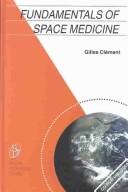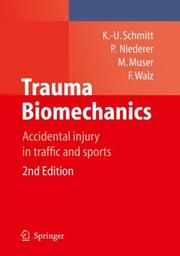| Listing 1 - 2 of 2 |
Sort by
|

ISBN: 1280969504 9786610969500 1402034342 1402032463 1402015984 Year: 2007 Publisher: Dordrecht, NE : Springer,
Abstract | Keywords | Export | Availability | Bookmark
 Loading...
Loading...Choose an application
- Reference Manager
- EndNote
- RefWorks (Direct export to RefWorks)
A total of more than 240 human space flights have been completed to date, involving about 450 astronauts from various countries, for a combined total presence in space of more than 70 years. The seventh long-duration expedition crew is currently in residence aboard the International Space Station, continuing a permanent presence in space that began in October 2000. During that time, investigations have been conducted on both humans and animal models to study the bone demineralization and muscle deconditioning, space motion sickness, the causes and possible treatment of postflight orthostatic intolerance, the changes in immune function, crew and crew-ground interactions, and the medical issues of living in a space environment, such as the effects of radiation or the risk of developing kidney stones. Some results of these investigations have led to fundamental discoveries about the adaptation of the human body to the space environment. Gilles Clément has been active in this research. This readable text presents the findings from the life science experiments conducted during and after space missions. Topics discussed in this book include: adaptation of sensory-motor, cardio-vascular, bone, and muscle systems to the microgravity of spaceflight; psychological and sociological issues of living in a confined, isolated, and stressful environment; operational space medicine, such as crew selection, training and in-flight health monitoring, countermeasures and support; results of space biology experiments on individual cells, plants, and animal models; and the impact of long-duration missions such as the human mission to Mars. The author also provides a detailed description of how to fly a space experiment, based on his own experience with research projects conducted onboard Salyut-7, Mir, Spacelab, and the Space Shuttle. Now is the time to look at the future of human spaceflight and what comes next. The future human exploration of Mars captures the imagination of both the public and the scientific community. Many physiological, psychological, operational, and scientific issues need to be solved before the first crew can explore the enigmatic Red Planet. This book also identifies the showstoppers that can be foreseen and what we need to learn to fully understand the implications and risks of such a mission.
Space medicine. --- Space flight --- Physiological effect. --- Manned space flight --- Aerospace medicine --- Bioastronautics --- Physiological effect --- Physics. --- Medicine. --- Life sciences. --- Astronomy. --- Astrophysics. --- Cosmology. --- Automotive engineering. --- Social sciences. --- Astronomy, Astrophysics and Cosmology. --- Automotive Engineering. --- Life Sciences, general. --- Medicine/Public Health, general. --- Social Sciences, general. --- Space biology --- Space medicine --- Medicine --- Space sciences --- Transportation medicine --- Aviation medicine --- Engineering. --- Behavioral sciences --- Human sciences --- Sciences, Social --- Social science --- Social studies --- Civilization --- Clinical sciences --- Medical profession --- Human biology --- Life sciences --- Medical sciences --- Pathology --- Physicians --- Biosciences --- Sciences, Life --- Science --- Construction --- Industrial arts --- Technology --- Health Workforce --- Astronomical physics --- Astronomy --- Cosmic physics --- Physics

ISBN: 354073872X 9786611043582 1281043583 3540738738 Year: 2007 Publisher: Berlin, Heidelberg : Springer Berlin Heidelberg : Imprint: Springer,
Abstract | Keywords | Export | Availability | Bookmark
 Loading...
Loading...Choose an application
- Reference Manager
- EndNote
- RefWorks (Direct export to RefWorks)
Trauma biomechanics uses the principles of mechanics to study the response and tolerance level of biological tissues under extreme loading conditions. Through an understanding of mechanical factors that influence the function and structure of human tissues, countermeasures can be developed to alleviate or even eliminate such injuries. Trauma Biomechanics surveys a wide variety of topics in injury biomechanics including injury classification, injury mechanisms and injury criteria. Both injuries sustained in automotive accidents and in sports are addressed. The interdisciplinary approach necessary in trauma biomechanics is stressed by showing the span from anatomy for each body region to engineering solutions for protection against injury. Injury tolerance values are listed, either currently in use or proposed by both the U.S. and European countries. Although the book is meant as a first introduction for engineers and medical doctors, sufficient references for scientific research are provided also.
Crash injuries. --- Human mechanics. --- Traumatology. --- Crash injuries --- Human mechanics --- Traumatology --- Whiplash Injuries --- Finite Element Analysis --- Soft Tissue Injuries --- Fractures, Bone --- Investigative Techniques --- Wounds and Injuries --- Neck Injuries --- Analytical, Diagnostic and Therapeutic Techniques and Equipment --- Diseases --- Wounds & Injuries --- Surgery & Anesthesiology --- Health & Biological Sciences --- Accident medicine --- Trauma medicine --- Body mechanics, Human --- Human biomechanics --- Human movements --- Movements, Human --- Engineering. --- Forensic medicine. --- Pathology. --- Structural mechanics. --- Automotive engineering. --- Biomedical engineering. --- Biomedical Engineering. --- Structural Mechanics. --- Forensic Medicine. --- Automotive Engineering. --- Emergency medicine --- Surgery --- Wounds and injuries --- Animal mechanics --- Human physiology --- Physical anthropology --- Kinesiology --- Impact --- Transportation medicine --- Physiological effect --- Mechanics. --- Mechanics, Applied. --- Biomedical Engineering and Bioengineering. --- Solid Mechanics. --- Construction --- Industrial arts --- Technology --- Disease (Pathology) --- Medical sciences --- Medicine --- Medicine, Preventive --- Forensic medicine --- Injuries (Law) --- Jurisprudence, Medical --- Legal medicine --- Forensic sciences --- Medical laws and legislation --- Applied mechanics --- Engineering, Mechanical --- Engineering mathematics --- Classical mechanics --- Newtonian mechanics --- Physics --- Dynamics --- Quantum theory --- Clinical engineering --- Medical engineering --- Bioengineering --- Biophysics --- Engineering
| Listing 1 - 2 of 2 |
Sort by
|

 Search
Search Feedback
Feedback About UniCat
About UniCat  Help
Help News
News